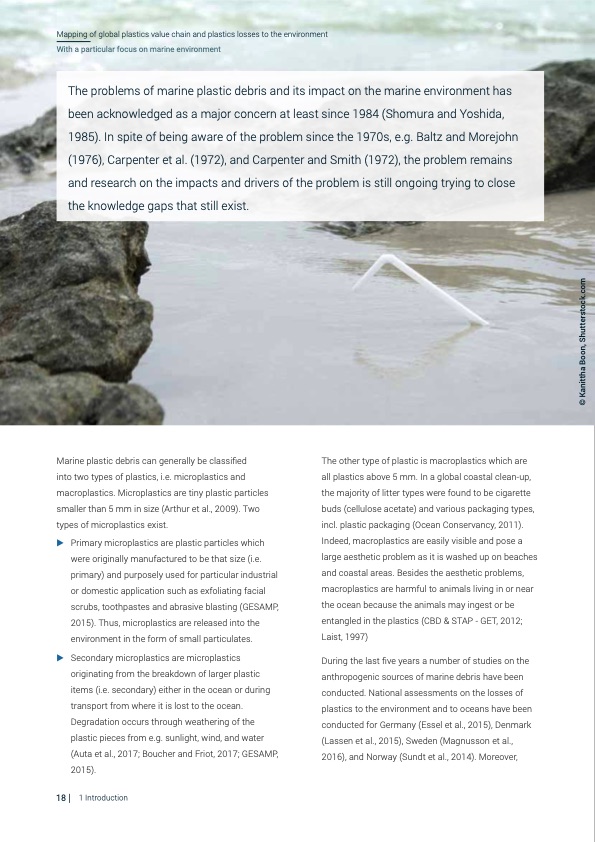
PDF Publication Title:
Text from PDF Page: 020
Mapping of global plastics value chain and plastics losses to the environment With a particular focus on marine environment The problems of marine plastic debris and its impact on the marine environment has been acknowledged as a major concern at least since 1984 (Shomura and Yoshida, 1985). In spite of being aware of the problem since the 1970s, e.g. Baltz and Morejohn (1976), Carpenter et al. (1972), and Carpenter and Smith (1972), the problem remains and research on the impacts and drivers of the problem is still ongoing trying to close the knowledge gaps that still exist. Marine plastic debris can generally be classified into two types of plastics, i.e. microplastics and macroplastics. Microplastics are tiny plastic particles smaller than 5 mm in size (Arthur et al., 2009). Two types of microplastics exist. The other type of plastic is macroplastics which are all plastics above 5 mm. In a global coastal clean-up, the majority of litter types were found to be cigarette buds (cellulose acetate) and various packaging types, incl. plastic packaging (Ocean Conservancy, 2011). Indeed, macroplastics are easily visible and pose a large aesthetic problem as it is washed up on beaches and coastal areas. Besides the aesthetic problems, macroplastics are harmful to animals living in or near the ocean because the animals may ingest or be entangled in the plastics (CBD & STAP - GET, 2012; Laist, 1997) During the last five years a number of studies on the anthropogenic sources of marine debris have been conducted. National assessments on the losses of plastics to the environment and to oceans have been conducted for Germany (Essel et al., 2015), Denmark (Lassen et al., 2015), Sweden (Magnusson et al., 2016), and Norway (Sundt et al., 2014). Moreover, ▶ ▶ Primary microplastics are plastic particles which were originally manufactured to be that size (i.e. primary) and purposely used for particular industrial or domestic application such as exfoliating facial scrubs, toothpastes and abrasive blasting (GESAMP, 2015). Thus, microplastics are released into the environment in the form of small particulates. Secondary microplastics are microplastics originating from the breakdown of larger plastic items (i.e. secondary) either in the ocean or during transport from where it is lost to the ocean. Degradation occurs through weathering of the plastic pieces from e.g. sunlight, wind, and water (Auta et al., 2017; Boucher and Friot, 2017; GESAMP, 2015). 18 | 1 Introduction © Kanittha Boon, Shutterstock.comPDF Image | Mapping of global plastics value chain

PDF Search Title:
Mapping of global plastics value chainOriginal File Name Searched:
2018-plastics-global-hotspots.pdfDIY PDF Search: Google It | Yahoo | Bing
Development of a solar powered Electric Ship The Electricship website originally started off as a project to develop a comprehensive renewable, affordable, modular electric ship... More Info
Modular Boat Hull Composite The case for a unsinkable, modular composite hybrid boat hull... More Info
MS Burgenstock Hybrid Electric Catamaran Lake Lucerne Unique shuttle servicing Lucerne to the Burgenstock Resort... More Info
Ground Power Unit GPU Powered by Lithium Ion Batteries The goal of the Ground Power Unit is to provide a readily accessible, modular, ready-to-power solution for remote power... More Info
| CONTACT TEL: 608-238-6001 Email: greg@electricship.com | RSS | AMP |